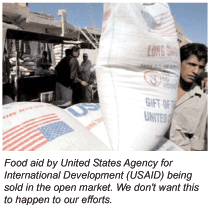First of all, let’s settle one point about this model: Even though many companies may be attracted to the idea, it would remain within the realm of corporate philanthropy and not CSR for companies that are not in the food business per se.
Brass Tacks What is the Product?
It’s an almost ready-to-eat meal that can sustain a large number of the population.
It comes in a box, so it can be easily transported over long distances.
It is culturally sensitive so it does not smell of “western imperialism” – a common problem when food aid is distributed.
Of course, it must be nutritionally and calorically-sound, and verified to be so for its intended ‘consumers’.
Pricing?
In terms of whether it should be free or it should be subsidized, I tend to lean on the side of subsidy, unless there is such a wide-scale famine that emergency measures are needed.
However, the pricing needs to be realistic keeping in view that the poorest of the poor are often working in subsistence situations where they may actually only have barter options available to them.
Distribution
There are two target areas for this product:
Those who are living in extremely far-flung areas, engaged in some form of subsistence agriculture, exposed to weather shocks and are thus food insecure.
Those living in urban slums whose children may be malnourished due to poverty or neglect.
Marketing
A franchise system needs to be developed for ‘kiryana’/village stores or a new brand of store needs to be created in order to distribute the product. This may be tied into a system of ration cards or lists that have the backing of grass roots organizations. Frankly, this system of distribution at the last mile will make or break this model.
The Cross Subsidy Model
More affluent consumers, for instance those who are dining out are asked to either donate an amount via collection boxes or they are charged an amount on their bills directly through a foundation to which restaurants are signed up.
These amounts are used as a catalyst fund to create involvement of the affluent classes in the model. The money is then used to cross- subsidize the boxed meal.
Additional Benefit for The Food Organisations
Whoever develops this product will find a ready market in international food NGOs who are always looking at cost-effective and easy-to-execute products for international food crises.
Praise be to Allah Who feeds us, and Whose blessings we seek in our prayers when we reach out to those in need.







